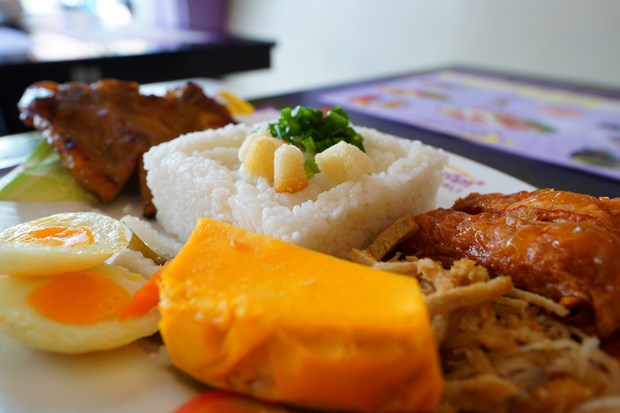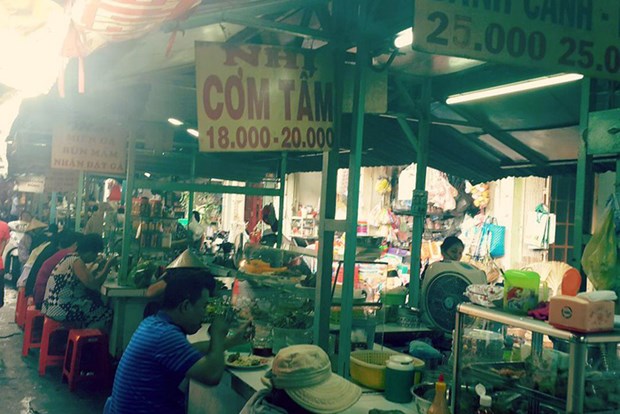With its peculiar taste and scent, broken rice has long been considered a favorite by people of all ages and economic backgrounds in Saigon, and only in this city can its true flavor be found.

A special version of 'com tam' offered at a fancy restaurant on Vo Van Tan Street, District 3, Ho Chi Minh City. Photo: Tien Bui
Com tam, as the food is called in
Vietnamese, basically refers to a rice dish whose main ingredient is broken
rice, a kind of rice that seems to have been smashed by a crushing machine.
A
single spoonful of the delicacy is well enough to strike one’s sense of taste
dumb with satisfaction.
The
spicy sauce adds not only to the aroma of the well-grilled pork and the smell
of oily onions that are served along with the rice, but it also adds to the
stiffness of the broken rice, creating a mixture of harmony, yet distinct with
varied flavors.

Com tam suon trung: broken rice with grilled pork and omelet sold for VND22,000 (~US$1.00) at a university in Ho Chi Minh City. Photo: Tien Bui
An upgrade of
ingredients
Com tam was originally consumed by the
poor who could not afford to enjoy the more refined version of rice.
According
to a TuoiTre News reader, decades ago
the Saigonese had to rely on crude rice processing machines which damaged the
final product.
The
damaged rice that fell out, the broken rice, was collected by poor workers and
turned into a basic rice dish for their daily existence.
Back
then, com tam was just a dish
consisting of rice, spicy sauce and oily onions.
But
somehow, the dish made it to roadside dining places, food stalls at local
markets, fancy restaurants, beyond the southern city, and even overseas.
Nowadays,
com tam comes with a handful of
options.
One
can order com tam together with one,
some or all of these: suon (grilled
pork), bi (long slices of seasoned
pork skin), trung (one or two
omelets), and cha (meatloaf with egg
yolk, mushroom, bean, meat and seasoning, sliced into small bars).
A
typical dish of com tam contains a
small portion of broken rice with some oily onions scattered on top, surrounded
by suon, bi, trung, or cha, as mentioned above.
To
vary the taste, the plate is accompanied by tomato and cucumber slices, some
sour vegetable stripes, or by a small bowl of vegetable soup.

The spicy sauce, generally deemed key to com tam. Photo: Tien Bui
Tasty, healthy, and
cheap
When
asked about her preference for this specialty, Ho Nhu Yen, an early-twenty
Saigon-based freelance teacher of English said, “I get to eat com tam once a week, sometimes by the
roadside and sometimes in a food store.”
Commenting
on her choice of com tam over other
kinds of rice dish, she stresses that the taste is unparallel.
“But
the important thing is com tam
normally comes in small portions, so I’m not afraid of getting fat even when I
have a plate late evening!” she added.
Many
believe the key to the success of any com
tam sellers is the recipe of their sauce.
Big
restaurants might have a reliable source of pork and high quality ingredients,
but some do not provide customers with the scent of sauce found elsewhere by
the roadside.
Com tam, originally a food for the
average-income laborers, still reigns in the street.
In
fact, com tam made list on CNN’s top
40 Vietnamese delicacies as an appetizing roadside dish.
For
VND18,000 - 30,000 (US$0.89 - 1.33), one can easily grab a plateful of com tam, both flavorsome and fulfilling.
People
might also choose to pay more for a nicer and quieter place rather than the
cheap roadside low tables and stools.
Some
restaurants charge VND80,000 ($3.54) or more for a special serve.

A roadside com tam seller in District 4, Ho Chi Minh City. Photo: Tuoi Tre
Where to find the
best ‘com tam’?
The
capital of Hanoi, the central Vietnam city of Da Nang, and other provinces do
offer com tam, but picky eaters will
not find themselves satisfied, as the original taste from the southern
metropolis cannot be duplicated.
Com tam is at its best only in Saigon for
some reason.
On
August 1, 2012, The Asia Record Organization recognized com tam Saigon (Saigon broken rice) amongst ten other Vietnamese
dishes for their gastronomic value in Faridabad, India.
Some
poets in Saigon have said that com tam
has never made it into Vietnamese literature and poems, unlike other
specialties like pho (Vietnamese beef noodle soup).
But
what hype is needed if it is all in people’s minds and diets?
If
the proof of the pudding is in the eating, then the proof of com tam is in its prevalence.
People
go for com tam in the morning. To the
Vietnamese people, especially those who work as manual laborers, a hearty
breakfast empowers their fruitful morning.
What
can better fill the stomach and energize the muscles than a plate of com tam?

Com tam offered by the roadside at Thi Nghe Market, District 1, Ho Chi Minh City. Photo: Tuoi Tre
Students,
white-collar workers, children, the elderly, all enjoy the flavor of the
renowned dish.
Com tam is also available for lunches.
But
it is most popular in the evening hours. Com
tam dem (night-time broken rice) is the sign hungry locals will look for
every here and there on the streets.
It
is child’s play looking for com tam,
as it is omnipresent under the cover of darkness!
Visitors
to Saigon cannot only try the taste of com
tam at numerous street food stalls that are scattered all over the city,
there are also restaurants such as Com
Tam Cali or Com Tam Thuan Kieu
who have specialized in serving the broken rice dish.
There
might be thousands of great foods out there for the Saigonese living in a city
blossoming with domestic and international cuisine, but at the back of their
minds, they know well com tam is on
the top list.
By Tien Bui /
Tuoi Tre News